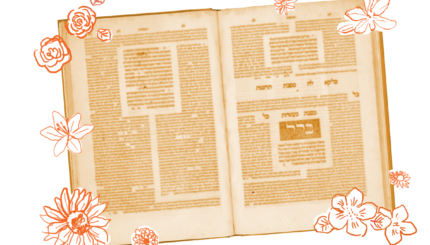From the 3rd century B.C.E on, the majority of Jews lived outside ancient Judea. Major cities such as Alexandria in Egypt, Antioch in Syria, and Rome itself all had large thriving Jewish communities at one time or another, while inscriptional evidence for Jewish communities has been found throughout virtually the entire Roman Empire. The following article recounts the experiences of Jewish women living in the ancient Diaspora. Reprinted from Jewish Women in Historical Perspective, edited by Judith Baskin, 1991, with permission of the Wayne State University Press.
In the second century C.E., in the city of Smyrna on the western coast of Asia Minor, a Jewish woman named Rufina commissioned the following Greek inscription on a marble slab: “Rufina, a Jewess, head of the synagogue, built this tomb for her freed slaves and the slaves raised in her household. No one else has the right to bury anyone [here]. Anyone who dares to do [so] will pay 1500 denaria to the sacred treasury and 1000 denaria to the Jewish people. A copy of this inscription has been placed in the [public] archives.”
Rufina’s inscription seems surprising for many reasons: Rufina, who has a Latin name, commissions an inscription in Greek, calls herself “head” or “president” of the synagogue, acts both autonomously and publicly without any reference to a father, husband, son, or male guardian; oversees her household of slaves and former slaves; and lives in sufficient social proximity to the non-Jewish community to prescribe a double penalty for anyone audacious enough to violate the tomb. By considering each of these aspects of Rufina’s inscription in detail, we may address most of the issues central to the study of Judaism and Jewish women in late antiquity […]
Economic Activity
To have commissioned such an inscription, Rufina of Smyrna must have been of substantial economic means. Not only were such inscriptions costly in and of themselves, the very content of the inscription reveals that Rufina owned property (the burial site) and slaves and was the head of a household. Regrettably, we cannot tell from this inscription how Rufina acquired her wealth, whether though inheritance or business or some combination.
How unique Rufina was in her economic status can only be considered within the context of the varied economic conditions of Jews in different communities and in different times in the Greco-Roman world. A substantial proportion of Jews in Rome may have been slaves or freedpersons, although in the ancient world financial status and social status were not always closely correlated: slaves and freedpersons could and did control substantial resources. The cumulative evidence from pagan writers, Christian sources, and the Jewish catacombs themselves, with their inscriptions, suggests that while some Jews in Rome had substantial wealth and perhaps social position, the majority did not.
Similarly, the relative poverty of the Jewish community at Leontopolis in Egypt may be inferred from the physical nature of the burial inscriptions found there, most of which are brief and stereotypical. Tax registers, commercial documents, and other papyri suggest that Jews who lived in rural Egyptian villages were also of modest means: the amount of the dowry in a Greek divorce decree reflects the low economic status of the wife’s family.
But the literary evidence and some of the epigraphical and papyrological evidence supports the view that many Jews living in Alexandria were financially comfortable. Like Rufina, Jews in the cities and towns of Asia Minor seem frequently to have been as well off as their neighbors and well integrated into the social and economic life of their communities.
Rufina’s inscription is typical in containing no information about her occupation, if any. The occupations of Jewish women are rarely mentioned in burial and donative inscriptions. However, the papyri transactions from Egypt make it clear that Jewish women engaged in commercial transactions of various sorts. In a document from the Fayun dated to 172/171 B.C.E., a woman named Sara guarantees a loan contracted by an unknown party.
A fragment from the same region dated to the middle of the second century B.C.E. lists the cattle, sheep, and goats owned by four Jewish women, while a tax register from Arsinoe in the same period lists six Jewish landowners, four of them women (Corpus papyrorum judaicarum [hereafter CPJ], nos. 28, 47). Jewish wet nurses are known from at least two papyri: in one the man engaging the woman’s services is clearly not Jewish, although the identity of the foundling baby she is to nurse is less certain.
Inscriptions from Asia Minor suggest that, like Rufina, Jewish women there had considerable financial independence and were publicly active. The individual names of women are routinely given in burial and other inscriptions, rather than identifying them only as the wife or daughter of some man.
Education
Regrettably, Rufina’s inscription sheds no direct light on the question of her formal education, although her role as archisynagogos, head of the synagogue, may well be indirect attestation of her ability to read and write. In general, the limited discussions of the education of Jewish women in late antiquity have, as usual, relied heavily on rabbinic sources for evidence.
[Scholar] Leonard Swidler, for example, assumes that Jewish education in this period is more or less identical with Torah and cites the standard rabbinic references against teaching women Torah. It is worth remembering that on this subject, as many others regarding women, different rabbis had different opinions; and, as I [have] noted earlier, many if not most Jews in this period did not, in any case, abide by rabbinic interpretations.
In reality, educated Jews in the Greco-Roman period, especially those in the Diaspora, undoubtedly studied far more than Jewish Scripture and its interpretation […] While it is highly unlikely that many Jews (men or women) were well educated in this period, some women clearly were, and that education consisted not only of the study of Jewish scriptures but of pagan literature as well.
The papyri, however, are replete with instances of women, both Jewish and non-Jewish, who could not write and therefore needed literate persons to sign documents on their behalf. This function was frequently met by a male relative acting as guardian, or kyrios. The phrase, “so-and-so wrote for her, because she is illiterate” is found on many papyri; it is also found often for men, most of whom were similarly illiterate.
Religious Lives
One of the most compelling and significant features of Rufina’s inscription is her designation as an archisynagogos, the head or president of a synagogue. Rufina is not unique in this regard. At least two other women heads of synagogue are known from inscriptions: Sophia of Gortyn, who was head of a synagogue at Kissamos on Crete, probably in the fourth or fifth century C.E., and Theopempte of Myndos in Caria, Asia Minor in the same period. Women are also attested as members of the councils of elders in Crete, in Thrace, on the island of Malta, in North Africa, and in Venosa, Italy and as “mothers of the synagogue” in Rome, Venetia, and Venosa, all in Italy.
Epitaphs and inscriptions commemorating financial contributions to synagogues confirm that women played a significant role not only in the governance of synagogue throughout the ancient Diaspora but also in maintaining the financial health of their communities.
Literary sources ranging from rabbinic texts to the New Testament and other early Christian writings make it clear that Jewish women routinely attended synagogue services. This evidence received vivid confirmation from an inscription found at Kymne in Western Asia Minor: “Taiton, daughter of Straton, son of Empedon, having erected the assembly hall and the enclosure of the open courtyard with her own funds, gave them as a gift to the Jews. The synagogue honored Tation, daughter of Straton, son o Empedon, with a golden crown and the privilege of sitting in the seat of honor.”
That Tation sits in the seat of honor may surprise those who assume, as have many scholars in the past, that men and women were separated in the synagogue, as is the case in contemporary orthodox Jewish practice. However [scholar] Bernadette Brooten’s exhaustive survey of archeological, literary, and epigraphical evidence reveals that there is currently no evidence from antiquity that women were routinely separated from men in synagogue worship nor that women sat in upstairs galleries or adjacent rooms.
Ross Kraemer is a Professor of Religious Studies at Brown University. Judith Baskin is the Director of the Harold Schnitzer Family Program in Judaic Studies and a Professor of Religious Studies at the University of Oregon. Reprinted from
Jewish Women in Historical Perspective
, edited by Judith Baskin, 1991, with permission of the Wayne State University Press. c. 1991 by Wayne State University Press.
Torah
Pronunced: TORE-uh, Origin: Hebrew, the Five Books of Moses.


